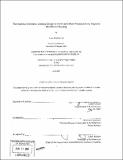| dc.contributor.advisor | Reinhard Goethert. | en_US |
| dc.contributor.author | Clouse, Carey Rose | en_US |
| dc.contributor.other | Massachusetts Institute of Technology. Dept. of Architecture. | en_US |
| dc.date.accessioned | 2007-10-22T17:39:20Z | |
| dc.date.available | 2007-10-22T17:39:20Z | |
| dc.date.copyright | 2007 | en_US |
| dc.date.issued | 2007 | en_US |
| dc.identifier.uri | http://hdl.handle.net/1721.1/39345 | |
| dc.description | Thesis (S.M.)--Massachusetts Institute of Technology, Dept. of Architecture, 2007. | en_US |
| dc.description | Includes bibliographical references (leaves 94-96). | en_US |
| dc.description.abstract | Architects have grappled with their role in the development of prefabricated building technologies and workforce housing for the last century. Historically, the architectural profession has witnessed limited participation and a narrow impact on this building type. As mass-production increasingly becomes a viable means of developing budget housing, and as companies seek to market these building products, architects stand to grow their role within the design field. This thesis is supported by a literature review, coupled with interviews and case studies. In compiling information from existing building projects, reflections from practicing experts, and theories from written work, projections for the future role of the architect have been developed. When architects participate in the development of prefabricated housing, they exchange their role as the client's direct representative for a more amorphous identity within the indirect retailing of architectural services. This shifting role effects changes to the entrenched and specific definition of architectural responsibility. | en_US |
| dc.description.abstract | (cont.) The architectural field will need to bend around new versions of liability and legal responsibility, different payment systems, an emphasis on generating design work that appeals to the majority, and the development of architecture as a product over a service. The building industry will need to shift as well, changing the way the job site is treated, their treatment of transportation, the development of materials, and the technological innovation embedded in architectural work. | en_US |
| dc.description.statementofresponsibility | by Carey Rose Clouse. | en_US |
| dc.format.extent | 97 leaves | en_US |
| dc.language.iso | eng | en_US |
| dc.publisher | Massachusetts Institute of Technology | en_US |
| dc.rights | M.I.T. theses are protected by copyright. They may be viewed from this source for any purpose, but reproduction or distribution in any format is prohibited without written permission. See provided URL for inquiries about permission. | en_US |
| dc.rights.uri | http://dspace.mit.edu/handle/1721.1/7582 | |
| dc.subject | Architecture. | en_US |
| dc.title | The indirect architect : linking design services and mass-production to improve workforce housing | en_US |
| dc.type | Thesis | en_US |
| dc.description.degree | S.M. | en_US |
| dc.contributor.department | Massachusetts Institute of Technology. Department of Architecture | |
| dc.identifier.oclc | 173611638 | en_US |
